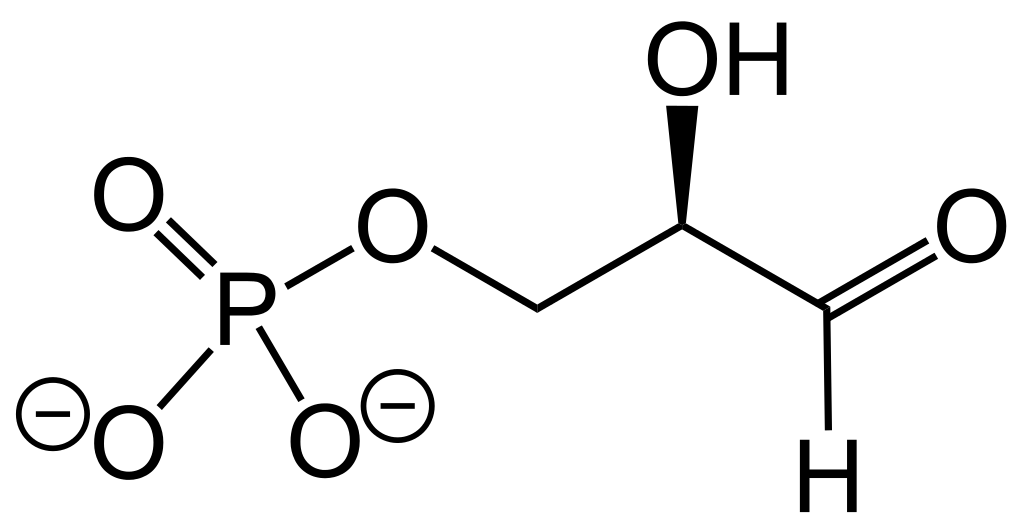The key difference between G3P and 3-PGA is that G3P has an aldehyde functional group at the carbon-3 position, whereas 3-PGA has a carboxylic acid functional group at the carbon 3 position.
G3P stands for glyceraldehyde 3-phosphate, while 3-PGA stands for 3-phosphoglyceric acid. These compounds are very important in different central pathways of living organisms. G3P is used as an intermediate in photosynthesis, tryptophan biosynthesis, and thiamine biosynthesis. Besides, 3-PGA is useful as a metabolic intermediate in both glycolysis and Calvin-Benson cycle, important in amino acid synthesis as a precursor for seine, etc.
CONTENTS
1. Overview and Key Difference
2. What is G3P
3. What is 3-PGA
4. G3P vs 3-PGA in Tabular Form
5. Summary – G3P vs 3-PGA
What is G3P?
G3P stands for glyceraldehyde 3-phosphate. It is also named triose phosphate or 3-phosphoglyceraldehyde. We can abbreviate it as G3P, GA3P, GADP, GAP, TP, GALP, or PGAL. We can identify it as a metabolite existing as an intermediate in different pathways of living organisms. The chemical formula of this compound is H(O)CCH(OH)CH2OPO32-. It is an anion that is a monophosphate ester of glyceraldehyde.

Figure 01: The Chemical Structure of G3P
G3P is important as an intermediate in both glycolysis and gluconeogenesis. This compound forms from three major compounds: beta-D-fructose 1,6-bisphosphate, dihydroxyacetone phosphate, and glyceraldehyde 3-phosphate. These compounds are useful as reactants in reversible reactions.
The most important roles of G3P are as an intermediate in photosynthesis, tryptophan biosynthesis, and thiamine biosynthesis.
What is 3-PGA?
3-PGA stands for 3-phosphoglyceric acid. It is the conjugate acid of phosphoglycerate. It is a biochemically significant substance that can act as a metabolic intermediate. It is important in both glycolysis and Calvin-Benson cycle. Often, the anion of this substance is named PGA.

Figure 02: The Chemical Structure of 3-PGA
When considering the Calvin-Benson cycle, 3-PGA is usually the product of the scission (spontaneous activity) of the unstable 6-carbon intermediate metabolite that forms from CO2 fixation. Therefore, there are two equivalents of 3-phosphoglycerate that form per each CO2 molecule, which is a fixed value. On the other hand, in glycolysis, this compound is useful as an intermediate that follows the dephosphorylation or the reduction of 1,3-bisphosphoglycerate.
Moreover, 3-PGA is important in amino acid synthesis as a precursor for seine. This is helpful in creating cysteine and glycine via the homocysteine cycle. We can easily separate 3-PGA from a sample through paper chromatography and column chromatography. Furthermore, we can easily identify it through both gas chromatography and liquid chromatography in combination with mass spectrometry.
What is the Difference Between G3P and 3-PGA?
G3P stands for glyceraldehyde 3-phosphate, while 3-PGA stands for 3-phosphoglyceric acid. The key difference between G3P and 3-PGA is that G3P has an aldehyde functional group at the carbon-3 position, whereas 3-PGA has a carboxylic acid functional group at the carbon 3 position.
Moreover, these compounds have different important roles in all living organisms. G3P is used as an intermediate in photosynthesis, in tryptophan biosynthesis, and in thiamine biosynthesis, while 3-PGA is useful as a metabolic intermediate in both glycolysis and Calvin-Benson cycle, important in amino acid synthesis as a precursor for seine, etc.
The following table summarizes the difference between G3P and 3-PGA.
Summary – G3P vs 3-PGA
G3P stands for glyceraldehyde 3-phosphate, while 3-PGA stands for 3-phosphoglyceric acid. The key difference between G3P and 3-PGA is that G3P has an aldehyde functional group at the carbon-3 position, whereas 3-PGA has a carboxylic acid functional group at the carbon 3 position.
Reference:
1. “3-Phosphoglyceric Acid.” Encyclopædia Britannica, Encyclopædia Britannica, Inc.
Image Courtesy:
1. “D-Glycerinaldehyde 3-phosphate deprotonated V1” By Jü – Own work (Public Domain) via Commons Wikimedia
2. “D-3-Phosphoglycerinsäure” By NEUROtiker (talk) – Own work (Public Domain) via Commons Wikimedia
ncG1vNJzZmivp6x7pbXFn5yrnZ6YsqOx07CcnqZemLyue9ahmK1lmah6tbTEZpuinpaav6a6wp5km52krLKmuoygaqllkaOxbn%2BMqZ6aZw%3D%3D